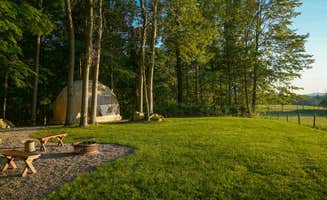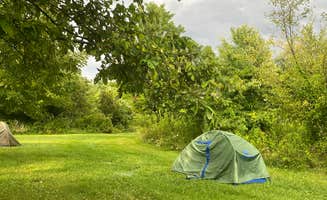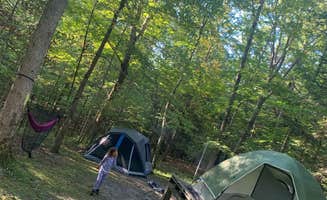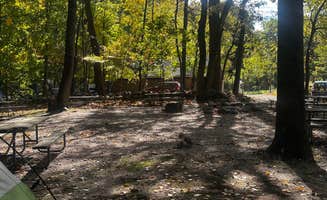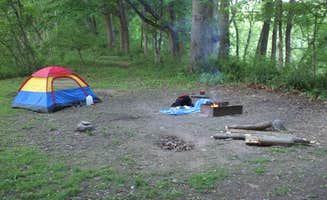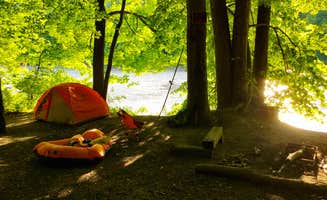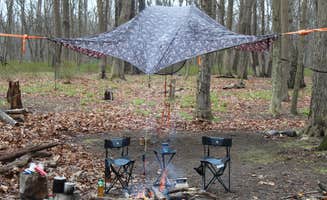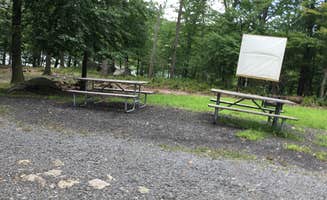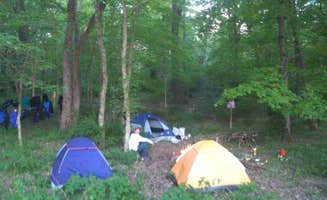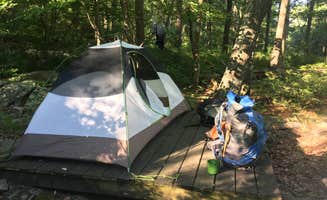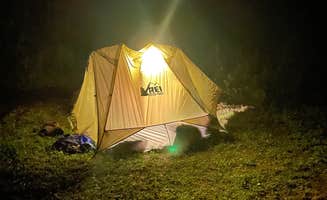The Kittatinny region near Hardyston, New Jersey sits at elevations between 400-1,800 feet, creating varied microclimates across camping areas. Winter temperatures often drop below freezing with significant snowfall, making most tent camping opportunities seasonal from April through October. Many primitive sites throughout the region require hikers to pack in all necessities including water, as natural sources may be unreliable during dry summer months.
What to do
Kayaking on Greenwood Lake: Located near Wawayanda State Park Campground, the lake offers excellent paddling opportunities. "Clean, access to kayaking/beach/trails. Largely friendly staff and campers," notes a visitor who particularly enjoyed the water activities despite some drawbacks with the campsite placement.
Hiking to scenic viewpoints: The Stonetown Circular trail Primitive #1 offers challenging terrain with significant rewards. "This is a great spot to set up camp because it has a wide area and an amazing view. You will find the site right next to the American Flag at the top of the mountain," explains a hiker who completed the trail.
Wildlife observation: Many campsites offer opportunities to spot native species. At Kittatinny Valley State Park, "You'll see deer and rabbits it's really spacious and beautiful. Site A is the best for seclusion and a spot closer to the lake (also amazing sunsets)," according to a frequent visitor who appreciates the natural setting.
What campers like
Complete seclusion on river islands: Namanock Island offers a unique camping experience only accessible by watercraft. "You totally feel that your party is alone out on the river, the entire world is yours and yours alone. There are no public interactions on the river for miles," explains a regular visitor who appreciates the isolation.
Natural swimming spots: Several locations offer swimming options beyond those mentioned in standard guides. "There's a lake at this campground that does have showers so I would recommend using those but if camping in the off season they may not be open," advises a camper at Wawayanda about the swimming facilities that might be overlooked by casual visitors.
Affordable primitive sites: Many campers appreciate the free or low-cost options available. At Stonetown Circular trail Primitive #2, visitors note, "This is a nice spot to set up camp because it is right next to a flowing stream with fresh water. The site is marked by a sign on a tree that says 'The Island'."
What you should know
Terrain challenges: Many sites require careful navigation. "Sites are hit or miss in terms of comfort, some have large, flat, clear spaces for multiple tents, some you have to wedge a tent to avoid rocks," notes a visitor to Jenny Jump State Forest, highlighting the variable terrain quality.
Water availability: Access varies significantly between locations. At Steam Mill Campground, there's a "short walk to the water spigot that is always running and ice cold," which is an important consideration when planning your stay and campsite selection.
Weather preparations: Temperature fluctuations can be extreme. "Took about 4.5 hours to paddle 3 miles then had to wave down a boat to tow me the rest of the mile. Was not fun!!!!" warns a Namanock Island camper who underestimated river currents, a common issue during certain seasons.
Noise considerations: Some otherwise excellent sites have unexpected noise issues. At Jenny Jump State Forest, "My only complaint is that the noise from the highway was quite loud at night," notes a camper who otherwise enjoyed the mountain setting.
Tips for camping with families
Accessible amenities: Some locations offer more comfort for families. At Kittatinny Valley State Park Campground, "The staff is wonderful here and they know the area like the back of their hand. Such a pleasant place to go for the weekend," making it easier for families needing local information.
Cabin options for mixed comfort levels: For families with members reluctant to tent camp, Moon Valley Campground provides alternatives. "This was a great campsite nestled in the foothills of Northern NJ on the NY border. Small, clean with great views and great location for hiking, cruising etc. Bring your tent or use the existing glamping tents."
Wildlife education opportunities: Many sites offer chances for children to observe native species safely. "Lots of peace and natural all around. Saw tons of bald eagles flying near the site and while paddles birds playing and baby geese with their mommas!" reports a Namanock Island visitor, highlighting the educational wildlife viewing possibilities.
Tips for RVers
Limited hookup availability: Most RV sites in the region have minimal services. "I stayed at group site 4 which was a very nice campsite. Not very much completely level terrain but nothing you can't sleep on," notes a Wawayanda camper, indicating the challenges even at established sites.
Road access considerations: Many roads to primitive sites are narrow or unpaved. Jenny Jump campers note that while sites accommodate small RVs, the mountain roads require careful navigation, especially during wet conditions.
Site selection for level parking: Finding level ground is crucial. "Steam Mill is one of the camping options in Stokes State Forest," where a visitor notes the importance of selecting sites carefully as many have significant grade changes that can make RV leveling difficult.


